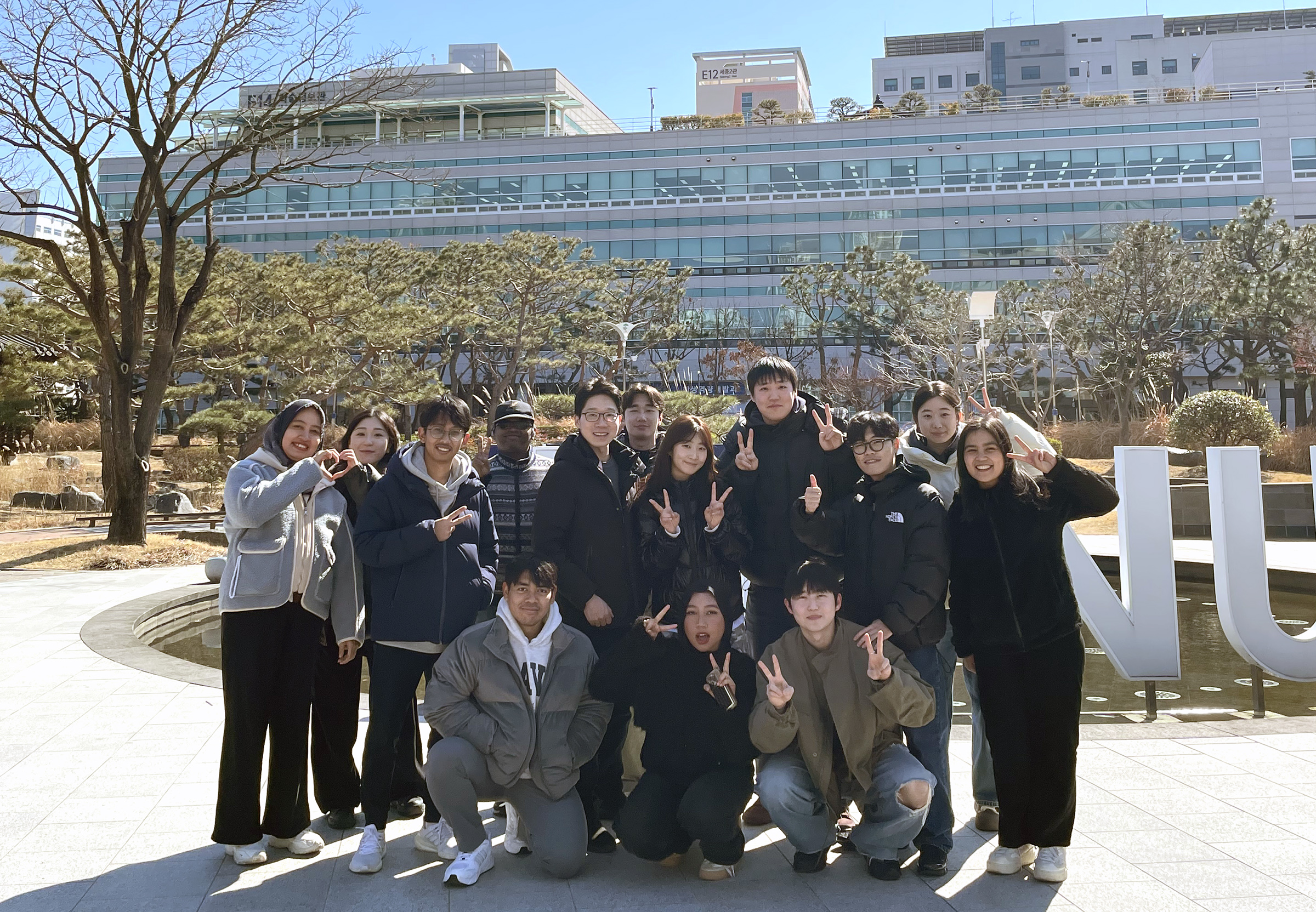커뮤니티
부경투데이
- 국립 부경대학교의 다양한 모습과 소식을 접하시면 부경대학교가 한번 더 가까워집니다.
| 부경·KIST, 차세대 하이드로겔 개발(Pukyong National University · KIST, Develop Next-Generation Hydrogel) | |||
| 작성자 | 대외홍보센터 | 작성일 | 2025-03-13 |
| 조회수 | 2066 | ||
| 부경·KIST, 차세대 하이드로겔 개발(Pukyong National University · KIST, Develop Next-Generation Hydrogel) | |||||
 |
대외홍보센터 |  |
2025-03-13 |  |
2066 |
국립부경대-KIST, 바닷물로 전기 생산 가능한 웨어러블 센서용 하이드로겔 개발
- 김용현 교수팀, 국제학술지 <Chemical Engineering Journal> 게재

△ 김용현 교수 연구팀.
전기가 잘 통하고 유연하며, 바닷물을 이용해 전기까지 생산하는 차세대 하이드로겔이 개발돼 주목받는다.
국립부경대 김용현 교수(디스플레이반도체공학전공)와 한국과학기술연구원(KIST) 김민석 박사 등 연구팀은 카르복시메틸 셀룰로오스(CMC)과 폴리비닐 알코올(PVA)에 전도성 고분자 소재 PEDOT:PSS(poly(3,4-Ethylenedioxythiophene):poly(styrenesulfonate))를 결합해 이 하이드로겔을 만들었다.
PEDOT:PSS는 CMC-PVA 기반 하이드로겔의 전기 전도도와 기계적 강도를 높이는 핵심 소재다. 김용현 교수의 교원창업기업 AH머티리얼즈가 개발한 이 소재는 반복적인 움직임에도 안정적인 전기 신호를 유지하며, 가교제를 추가해 내구성과 성능을 더욱 개선했다.
이번에 개발된 하이드로겔은 뛰어난 전기적 특성과 기계적 유연성, 신축성을 갖춰 피부에 부착해 실시간으로 사람의 움직임을 감지하는 웨어러블 센서로 활용할 수 있다.
연구팀은 이 하이드로겔로 제작한 센서를 신체 여러 부위에 붙여 생체 신호를 모니터링하고, AI로 데이터를 분석해 높은 정확도를 입증했다. 우수한 특성으로 피부에 부착하는 것은 물론, 의류에 통합하는 방식으로 활용하는 것도 가능해 의료 서비스의 편의성과 정확성을 크게 높일 것으로 기대된다.
특히 연구팀은 이 하이드로겔의 친환경 재생에너지 소재 가능성까지 확인했다. 연구팀이 하이드로겔 내 수분과 바닷물의 이온 농도 차이를 이용해 전기를 생산하는 실험을 진행한 결과 LED를 밝힐 수 있는 정도의 전압이 생성되는 것을 확인했다.
이 연구결과를 담은 논문 ‘Extremely-low electrical-hysteresis hydrogels for multifunctional wearable sensors and osmotic power generators’는 화학공학 분야의 세계적인 국제학술지 <Chemical Engineering Journal>(IF=13.4)에 최근 게재됐다.
이번 연구를 이끈 김용현 교수는 “전도성과 유연성을 동시에 갖춘 이 하이드로겔은 인체와 자연스럽게 통합되는 웨어러블 기기 개발과 소프트전자공학 분야 발전에 기여할 것으로 기대한다.”라고 밝혔다. 김민석 박사는 “자연의 염분을 활용한 전기 생산은 지속 가능한 에너지 분야 발전에 새로운 실마리를 제공한다.”라고 밝혔다. <부경투데이>
Pukyong National University-KIST, Develop Wearable Hydrogel Sensor Capable of Generating Electricity from Seawater
- Professor Kim Yong-hyun's Team Publishes in International Journal <Chemical Engineering Journal>
A next-generation hydrogel that is highly conductive, flexible, and capable of generating electricity using seawater has been developed, drawing attention.
Professor Kim Yong-hyun from Pukyong National University (Department of Display Semiconductor Engineering) and Dr. Kim Min-seok from the Korea Institute of Science and Technology (KIST) led a research team to create this hydrogel by combining carboxymethyl cellulose (CMC) and polyvinyl alcohol (PVA) with a conductive polymer material, PEDOT:PSS (poly(3,4-Ethylenedioxythiophene):poly(styrenesulfonate)).
PEDOT:PSS is a key material that enhances the electrical conductivity and mechanical strength of the CMC-PVA-based hydrogel. Developed by Kim Yong-hyun’s faculty startup, AH Materials, this material maintains stable electrical signals even with repetitive movements. The addition of a crosslinking agent further improves its durability and performance.
The hydrogel developed this time boasts excellent electrical properties, mechanical flexibility, and stretchability, making it suitable for use as a wearable sensor that can be attached to the skin to detect human movements in real-time.
The research team used hydrogel to create sensors that were attached to various parts of the body to monitor biometric signals. By analyzing the data with AI, they demonstrated high accuracy. With its excellent properties, this hydrogel can not only be applied to the skin but also integrated into clothing, significantly enhancing the convenience and accuracy of medical services.
In particular, the research team also confirmed the potential of this hydrogel as an eco-friendly renewable energy material. Through experiments that utilized the difference in ion concentration between the hydrogel's moisture and seawater, they were able to generate electricity capable of lighting an LED, proving its potential as a sustainable power source.
The research findings were published in the renowned international journal <Chemical Engineering Journal> (IF=13.4) under the title ‘Extremely-low electrical-hysteresis hydrogels for multifunctional wearable sensors and osmotic power generators.’
Professor Kim Yong-hyun, who led the research, stated, "This hydrogel, which combines conductivity and flexibility, is expected to contribute to the development of wearable devices that integrate naturally with the human body and the advancement of soft electronics." Dr. Kim Min-seok added, "Electricity generation using the natural salinity of seawater provides new insights into the development of sustainable energy." <Pukyong Today>